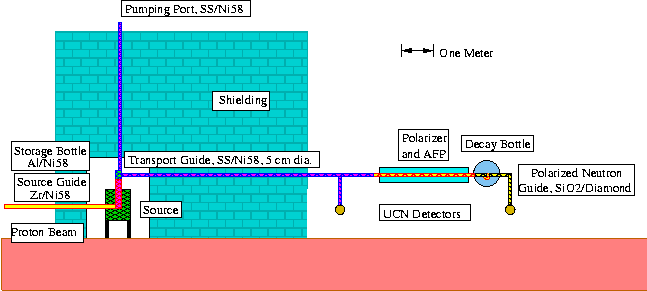 The
source of UCN for the A-correlation experiment is a tungsten spalation
target which is hit by the proton beam from the LANSCE accelerator.
The interaction of the beam with the target produces a large pulse of neutrons
which have to be cooled to become UCN. The cooling is done in several
steps: first with cold beryllium and polyethylene reflector and moderator,
then by solid deuterium via a phonon interaction. Once the UCN are
created they move through a 58Ni coated stainless steel guide
out of the shielding area and into the experiment hall. Once in the
hall the neutrons are polarized with a seven tesla superconducting magnet.
This is where the main part of the Virginia Tech responsibility starts;
after polarization the guides must be non conducting and non-magnetic.
The next section of guide takes the polarized UCN into the decay spectrometer
which is in a four meter one telsa superconducting solenoid. The
polarized UCN align in the solenoid field and when they decay the resulting
electron is then caught in a detector at either end of the decay trap.
The results are then analyzed to find the A-correlation. The
source of UCN for the A-correlation experiment is a tungsten spalation
target which is hit by the proton beam from the LANSCE accelerator.
The interaction of the beam with the target produces a large pulse of neutrons
which have to be cooled to become UCN. The cooling is done in several
steps: first with cold beryllium and polyethylene reflector and moderator,
then by solid deuterium via a phonon interaction. Once the UCN are
created they move through a 58Ni coated stainless steel guide
out of the shielding area and into the experiment hall. Once in the
hall the neutrons are polarized with a seven tesla superconducting magnet.
This is where the main part of the Virginia Tech responsibility starts;
after polarization the guides must be non conducting and non-magnetic.
The next section of guide takes the polarized UCN into the decay spectrometer
which is in a four meter one telsa superconducting solenoid. The
polarized UCN align in the solenoid field and when they decay the resulting
electron is then caught in a detector at either end of the decay trap.
The results are then analyzed to find the A-correlation. |
 The
source of UCN for the A-correlation experiment is a tungsten spalation
target which is hit by the proton beam from the LANSCE accelerator.
The interaction of the beam with the target produces a large pulse of neutrons
which have to be cooled to become UCN. The cooling is done in several
steps: first with cold beryllium and polyethylene reflector and moderator,
then by solid deuterium via a phonon interaction. Once the UCN are
created they move through a 58Ni coated stainless steel guide
out of the shielding area and into the experiment hall. Once in the
hall the neutrons are polarized with a seven tesla superconducting magnet.
This is where the main part of the Virginia Tech responsibility starts;
after polarization the guides must be non conducting and non-magnetic.
The next section of guide takes the polarized UCN into the decay spectrometer
which is in a four meter one telsa superconducting solenoid. The
polarized UCN align in the solenoid field and when they decay the resulting
electron is then caught in a detector at either end of the decay trap.
The results are then analyzed to find the A-correlation.
The
source of UCN for the A-correlation experiment is a tungsten spalation
target which is hit by the proton beam from the LANSCE accelerator.
The interaction of the beam with the target produces a large pulse of neutrons
which have to be cooled to become UCN. The cooling is done in several
steps: first with cold beryllium and polyethylene reflector and moderator,
then by solid deuterium via a phonon interaction. Once the UCN are
created they move through a 58Ni coated stainless steel guide
out of the shielding area and into the experiment hall. Once in the
hall the neutrons are polarized with a seven tesla superconducting magnet.
This is where the main part of the Virginia Tech responsibility starts;
after polarization the guides must be non conducting and non-magnetic.
The next section of guide takes the polarized UCN into the decay spectrometer
which is in a four meter one telsa superconducting solenoid. The
polarized UCN align in the solenoid field and when they decay the resulting
electron is then caught in a detector at either end of the decay trap.
The results are then analyzed to find the A-correlation.